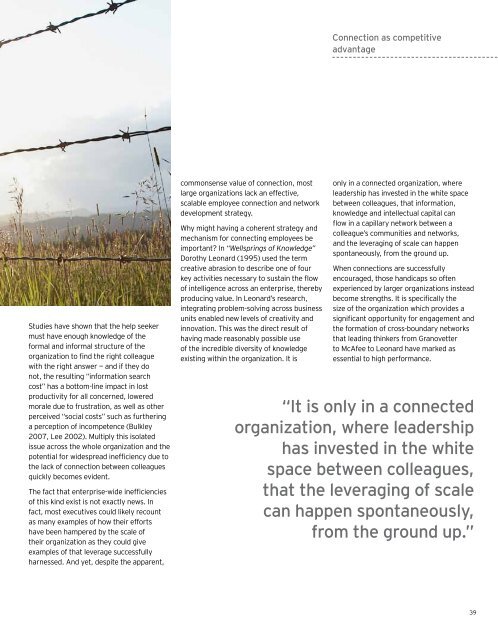PERF RMANCE 04 - The Performance Portal - Ernst & Young
PERF RMANCE 04 - The Performance Portal - Ernst & Young
PERF RMANCE 04 - The Performance Portal - Ernst & Young
Create successful ePaper yourself
Turn your PDF publications into a flip-book with our unique Google optimized e-Paper software.
Connection as competitive<br />
advantage<br />
Studies have shown that the help seeker<br />
must have enough knowledge of the<br />
formal and informal structure of the<br />
organization to find the right colleague<br />
with the right answer — and if they do<br />
not, the resulting “information search<br />
cost” has a bottom-line impact in lost<br />
productivity for all concerned, lowered<br />
morale due to frustration, as well as other<br />
perceived “social costs” such as furthering<br />
a perception of incompetence (Bulkley<br />
2007, Lee 2002). Multiply this isolated<br />
issue across the whole organization and the<br />
potential for widespread inefficiency due to<br />
the lack of connection between colleagues<br />
quickly becomes evident.<br />
<strong>The</strong> fact that enterprise-wide inefficiencies<br />
of this kind exist is not exactly news. In<br />
fact, most executives could likely recount<br />
as many examples of how their efforts<br />
have been hampered by the scale of<br />
their organization as they could give<br />
examples of that leverage successfully<br />
harnessed. And yet, despite the apparent,<br />
commonsense value of connection, most<br />
large organizations lack an effective,<br />
scalable employee connection and network<br />
development strategy.<br />
Why might having a coherent strategy and<br />
mechanism for connecting employees be<br />
important? In “Wellsprings of Knowledge”<br />
Dorothy Leonard (1995) used the term<br />
creative abrasion to describe one of four<br />
key activities necessary to sustain the flow<br />
of intelligence across an enterprise, thereby<br />
producing value. In Leonard’s research,<br />
integrating problem-solving across business<br />
units enabled new levels of creativity and<br />
innovation. This was the direct result of<br />
having made reasonably possible use<br />
of the incredible diversity of knowledge<br />
existing within the organization. It is<br />
only in a connected organization, where<br />
leadership has invested in the white space<br />
between colleagues, that information,<br />
knowledge and intellectual capital can<br />
flow in a capillary network between a<br />
colleague’s communities and networks,<br />
and the leveraging of scale can happen<br />
spontaneously, from the ground up.<br />
When connections are successfully<br />
encouraged, those handicaps so often<br />
experienced by larger organizations instead<br />
become strengths. It is specifically the<br />
size of the organization which provides a<br />
significant opportunity for engagement and<br />
the formation of cross-boundary networks<br />
that leading thinkers from Granovetter<br />
to McAfee to Leonard have marked as<br />
essential to high performance.<br />
“It is only in a connected<br />
organization, where leadership<br />
has invested in the white<br />
space between colleagues,<br />
that the leveraging of scale<br />
can happen spontaneously,<br />
from the ground up.”<br />
39






